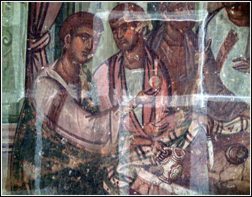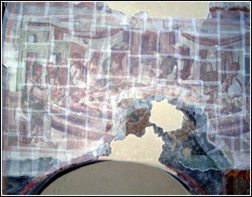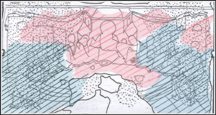BLAGO BLOG
OUR BLOG
Article Index
FRESCO: THE LAST SUPPER
Located on the southern wall of the cupola base just above the choir, the Last Supper is the only surviving composition from a reconstructive painting effort that took place centuries after the original one, though its exact period is in dispute. One thesis on stylistic grounds considers this work of the renowned master Longin, whose school emanated from the restored Pec Patriarchate around 1568. The other possibility is that the work dates to shortly after the 1657 embassy of the Mileseva brotherhood to Russian czar Alexei Mikhailovich, who donated 300 rubles for a thorough monastery repainting. Multiple areas of damage reveal details of the older underpainting, whose exact size and state are not exactly known, though iconographic elements clearly suggest a depiction of Christs descent into Hell.
Urgently needed is the complete removal of the whole fresco, in maximally intact shape, for off-site processing. This is to be followed by structurally securing of its backside, the creation of a new base (for adhesion of the fresco), and final presentation for on or off-site exhibit. This would simultaneously reveal the remaining portions of the older Christs descent into Hell composition in its original setting. This fresco will also require additional cleaning and conservation. |
In 1995 the whole fresco was placed under a glaze protective layer that fixes the fresco layer to the wall. The recent detailed examination focused on the state of painting under the gauze. The protective layer itself is in good condition, without degradation; however, its role is only partially structural and in any case temporary. The actual state of the Last Supper composition it covers can only be vaguely discerned at this point, although no recent degradation has been detected. The key problem and
pressing issue is the separation of the fresco layer from the base layer. The areas of damage with visible remains of the older fresco suggest its surface was picked, in a typical move used to ensure better adhesion of the new mortar layer. Sonar analysis suggests that about 80-90% of the new layer has been separated from the old base layer, leaving the real possibility of its complete separation in case of even a moderate tremor, since the preventative securing with gauze tape is limited in scope.
Surface separation of the fresco required securing it under a gauze protective layer in 1995.
|
||||||
More Information
BLAGO Content
While the content of the BLAGO Fund collections is free to use, there are also some restrictions on commercial use and proper attribution of the material. Follow the links below for more information.
> BLAGO Collections License
> Image Request
BLAGO Fund also accepts the contribution of material. Please contact us with any material you wish to publish on our website.
Contact
BLAGO Fund, Inc.
PO Box 60524
Palo Alto, CA 94306
USA
info@blagofund.org




